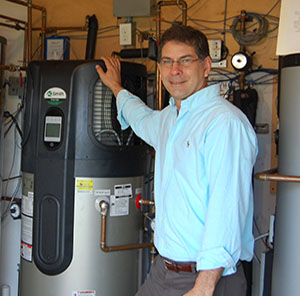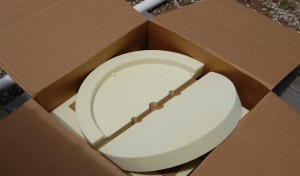Carlos Colon and the Simple Brilliance for Energy Efficient Water Heaters

Carlos Colon standing with an efficient heat pump water heater used to compare performance against a baseline electric water heater.
February 2, 2015
Bright blue, trimmed in canary yellow and fire-engine red, the Florida Solar Energy Center wouldn’t strike you as a pillar of UCF research at first glance. But this institute serves as a ‘primary’ example of America’s Partnership University.
UCF’s outpost on the Space Coast since 1975, the Florida Solar Energy Center is affectionately known as FSEC by researchers like Carlos Colon that call it home. His 25 years at FSEC shed light on the center’s past, present, and future: conducting research, testing and certifying solar systems, and developing educational programs.
We start off in the atrium where anyone is welcome to tour and learn more about the possibilities and potential of solar energy. He tells me there’s more energy falling on the roof of my house today than what I could use. Clean, renewable energy is there for the taking if researchers like those at FSEC can figure out how to capture it.
“We’re not there yet, but we’re slowly getting there,” he says.
Simple Brilliance for Energy Efficient Water Heaters
Read the next part of this month’s Faculty Feature on March 2nd
Through hallways and more buildings, further into FSEC’s campus, Colon opens a gate to the home of his research. As a part of his energy research, Colon has worked on an energy-saving invention for water heaters while performing system evaluations for more than five years. His work on the project is supported by internal FSEC funding, dedicated to enhancing research activities, and grants from partners including the Department of Energy and the Florida Natural Gas Association.
The scene in view is a collection of projects in motion with no space wasted, more utilitarian than what you’d see on the cover of a brochure. In a cottage-like shed, water heaters are hooked up to sensors as if they’re in an intensive care unit. The machines create a rhythmic hum and buzz, mechanical controls blink lights of every color as they mimic an average family’s demand for hot water.

A high density foam cap used to create molds for the thermal insulation cap for electric water heaters.
From standard to high-efficiency, these heaters have been Colon’s test subjects, helping him develop the new thermal insulator that conserves energy and helps consumers save money in a simple way.
His project began with a challenge from Danny Parker, Colon’s mentor and colleague whose work at the time included measuring the impact of water heater tank wraps for electric water heaters. The challenge from Parker to Colon was to extend the concept of additional insulation—an improved jacket added around a water heater to retain the heat it produced, allowing it to minimize energy consumption—for both electric and gas water heaters.
“A standard minimum code natural gas heater operates in the range of 60 percent [efficiency],” he says. “That’s because you’ve got a cylindrical vent in the center of the tank where you route the flue and the exhaust for the burner gases. So now you’ve got all this energy from within the inside and outer jacket surface area that’s losing heat all day, waiting for you to use the hot water.”
Colon first thought insulating a heater with a hole in the top was ridiculous, saying, “That’s crazy, it won’t do any good, there’s a hole in the top!” He’s since discovered what a difference it could make while perfecting his design for additional water heater insulation. The simple brilliance is founded on this: heat rises. Wrapping the sides of water heaters improves their efficiency slightly, but doesn’t address more significant heat loss at the top.
“You insulate an electric water heater, and it saves you about 4 percent annually,” he explains. Insulating a natural gas heater saves 6 percent annually. “It doesn’t sound like much, but if you do this with over 10 million water heaters throughout the U.S., then you’ve saved a huge amount of energy.”
“The other thing that most people don’t realize is that for every kilowatt-hour you use on-site, penalties incur due to losses associated with generation, transmission wires, transformers, etc. So for every kilowatt-hour that you use on-site… there is a 3:1 source-to-site ratio overall loss in the process. That’s a lot of loss.”
One of many projects at the Florida Solar Energy Center, Colon’s work offers a snapshot of the research process. It starts with a challenge and a tenacious belief that there’s always room for improvement. It takes time, dedication, and a fresh look at old problems. It’s a reminder that big changes can start small, and to never underestimate the power of a straightforward solution. From the new water heater insulator to all that’s happening at FSEC: when everything’s all wrapped up and topped off, consumers and industry can do more with less energy.
Check out the rest of this month’s Faculty Feature series for more about FSEC in part 2 on March 2nd.
Read more about other technologies at the UCF Technology Locator.
>>Written by Lisa Bottomley